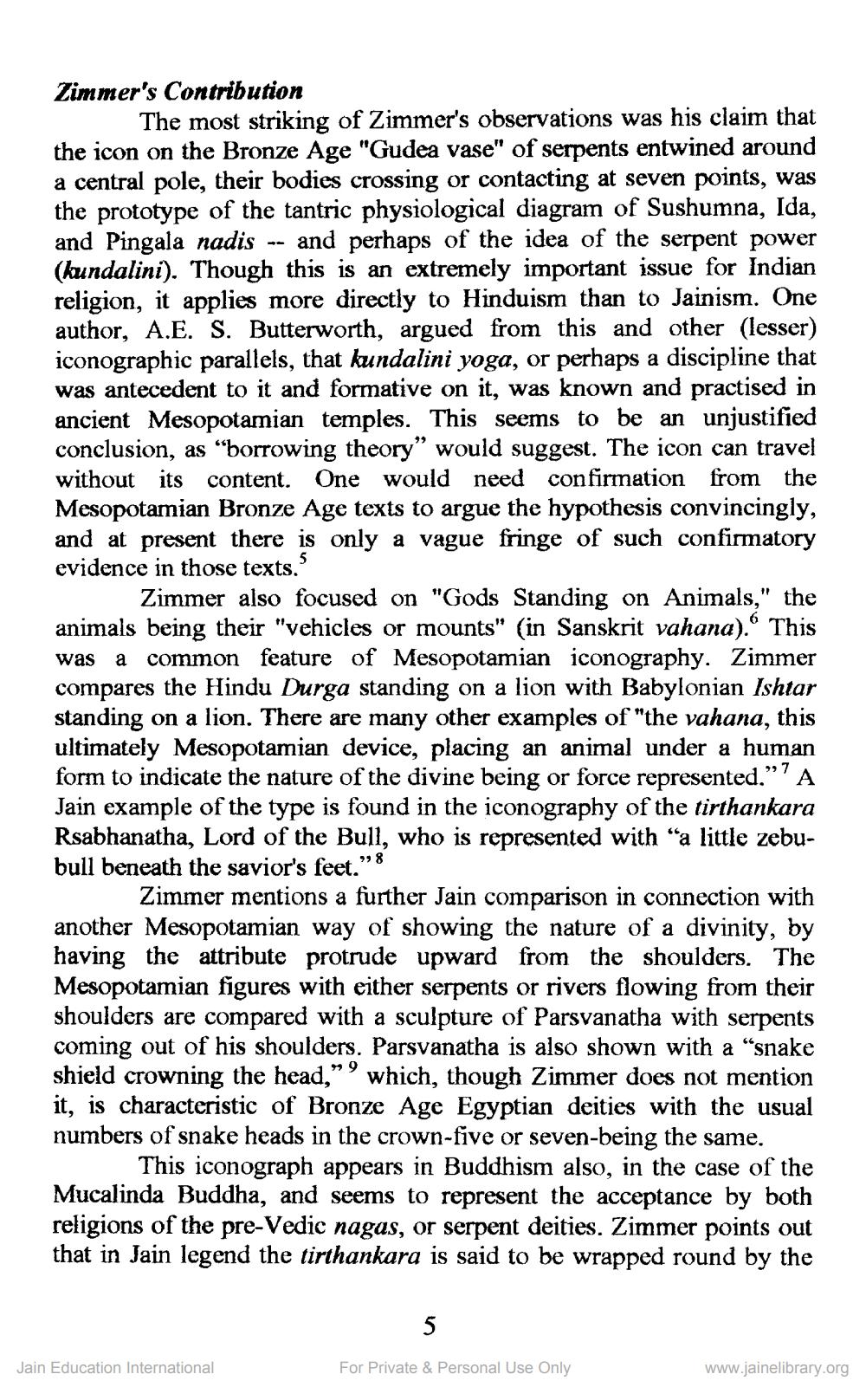Book Title: Jinamanjari 2002 04 No 25 Author(s): Jinamanjari Publisher: Canada Bramhi Jain Society Publication View full book textPage 9
________________ Zimmer's Contribution The most striking of Zimmer's observations was his claim that the icon on the Bronze Age "Gudea vase" of serpents entwined around a central pole, their bodies crossing or contacting at seven points, was the prototype of the tantric physiological diagram of Sushumna, Ida, and Pingala nadis and perhaps of the idea of the serpent power (kundalini). Though this is an extremely important issue for Indian religion, it applies more directly to Hinduism than to Jainism. One author, A.E. S. Butterworth, argued from this and other (lesser) iconographic parallels, that kundalini yoga, or perhaps a discipline that was antecedent to it and formative on it, was known and practised in ancient Mesopotamian temples. This seems to be an unjustified conclusion, as "borrowing theory" would suggest. The icon can travel without its content. One would need confirmation from the Mesopotamian Bronze Age texts to argue the hypothesis convincingly, and at present there is only a vague fringe of such confirmatory evidence in those texts. 5 -- 6 Zimmer also focused on "Gods Standing on Animals," the animals being their "vehicles or mounts" (in Sanskrit vahana). This was a common feature of Mesopotamian iconography. Zimmer compares the Hindu Durga standing on a lion with Babylonian Ishtar standing on a lion. There are many other examples of "the vahana, this ultimately Mesopotamian device, placing an animal under a human form to indicate the nature of the divine being or force represented."7 A Jain example of the type is found in the iconography of the tirthankara Rsabhanatha, Lord of the Bull, who is represented with "a little zebubull beneath the savior's feet.' "8 Zimmer mentions a further Jain comparison in connection with another Mesopotamian way of showing the nature of a divinity, by having the attribute protrude upward from the shoulders. The Mesopotamian figures with either serpents or rivers flowing from their shoulders are compared with a sculpture of Parsvanatha with serpents coming out of his shoulders. Parsvanatha is also shown with a "snake shield crowning the head," which, though Zimmer does not mention it, is characteristic of Bronze Age Egyptian deities with the usual numbers of snake heads in the crown-five or seven-being the same. "9 This iconograph appears in Buddhism also, in the case of the Mucalinda Buddha, and seems to represent the acceptance by both religions of the pre-Vedic nagas, or serpent deities. Zimmer points out that in Jain legend the tirthankara is said to be wrapped round by the Jain Education International For Private & Personal Use Only www.jainelibrary.orgPage Navigation
1 ... 7 8 9 10 11 12 13 14 15 16 17 18 19 20 21 22 23 24 25 26 27 28 29 30 31 32 33 34 35 36 37 38 39 40 41 42 43 44 45 46 47 48 49 50 51 52 53 54 55 56 57 58 59 60 61 62 63 64 65 66 67 68 69 70 71 72 73 74 75 76
